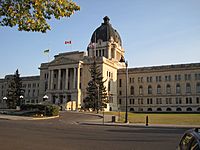Heritage Property Act (Saskatchewan) facts for kids
Quick facts for kids Heritage Property Act |
|
|---|---|

The Saskatchewan Legislative Building and its grounds were designated a Provincial Heritage Property in 1978
|
|
| An Act to provide for the Preservation, Interpretation and Development of Certain Aspects of Heritage Property in Saskatchewan, to provide for the continuance of the Saskatchewan Heritage Foundation and to provide for the naming of Geographic Features | |
| Citation | SS 1979-80, c H-2.2 |
| Territorial extent | Saskatchewan |
| Enacted by | Legislative Assembly of Saskatchewan |
| Date enacted | November 28, 1980 |
The Heritage Property Act is a special law in Saskatchewan, Canada. It helps protect important historical places, old archaeological sites, and places where ancient fossils are found. This law makes sure these special spots are kept safe for everyone to learn from and enjoy.
Contents
Protecting Saskatchewan's History
The Act has two main ways to protect important places:
Provincial Heritage Properties
These are places that are very important to the whole province of Saskatchewan. The Minister of Tourism, Parks, Culture and Sport officially names them. As of March 2013, there were 50 such places. Once a place is named a Provincial Heritage Property, you cannot change its special historical features without permission from the Minister. These places can also get money from the Saskatchewan Heritage Foundation to help keep them in good condition or fix them up.
Municipal Heritage Properties
These are places that are important to a local area, like a city, town, village, or rural municipality. Local governments can name these properties. This legal protection means the property is safe, and it can also get money from the Saskatchewan Heritage Foundation. There are more than 750 Municipal Heritage Properties in Saskatchewan.
The Act also lets local governments protect larger areas called Municipal Heritage Conservation Districts. The special value of these areas comes from their overall historical look, not just from one building.
Safeguarding Ancient Sites
The Act also protects archaeological and palaeontological sites and objects found in Saskatchewan. This means that any ancient object found in Saskatchewan belongs to the Crown (which represents the government and people). No one can dig up or move these objects without a special permit allowed by the Act.
The law also protects "Sites of Special Interest." These are important First Nations or Métis sites. They might have rock paintings, petroglyphs (carvings in rock), human bones, burial items, burial grounds, or special stone circles like medicine wheels. It is against the law to damage, change, or dig at these sites.
Other Important Parts of the Act
The Act also does a few other things:
- It created the Saskatchewan Heritage Foundation. This group's main job is to give money to projects that help protect heritage in the province.
- It set up the Saskatchewan Geographic Names Program. This program helps name places across Saskatchewan.
- It allows for temporary "stop orders." These orders can tell someone to stop an activity for up to 60 days if it looks like they might damage a heritage property.
- It lets landowners voluntarily agree to protect their heritage property. This means they make a deal with the province, a local government, or a heritage group to make sure the property stays safe.
- It explains that there are consequences for people who do not follow the rules of the Act.

